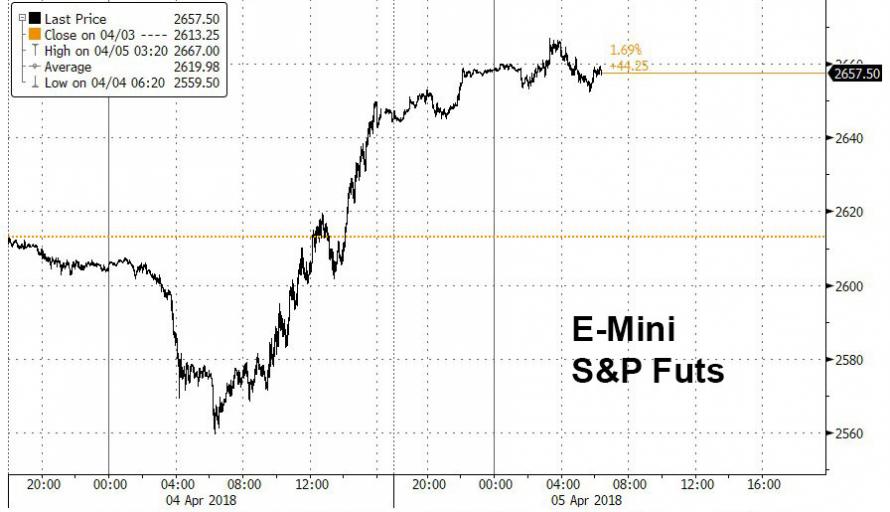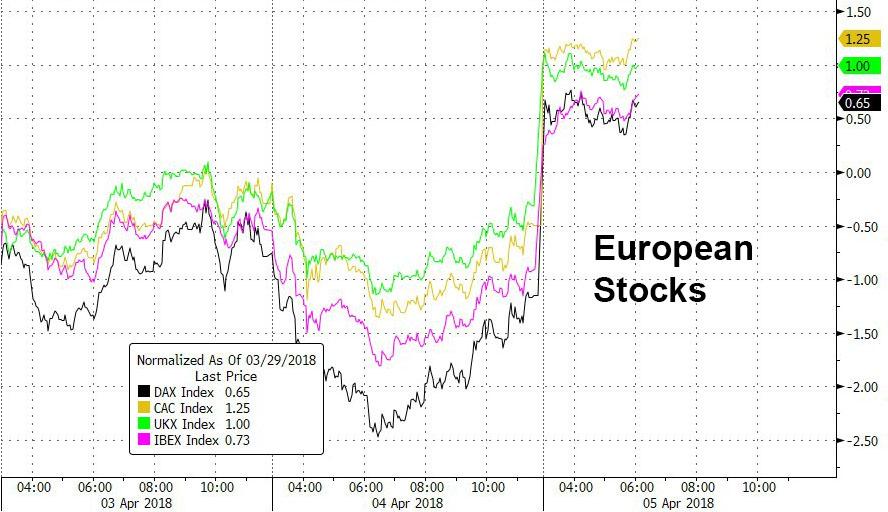Stocks across the globe rose in a continuation of yesterday’s euphoric rally that sent the Dow Jones nearly 1000 points higher from its session lows, as the moderation of trade war rhetoric – despite the tit-for-tat tariff announcements by China and the US – lifted risk sentiment across the board. As a result, whereas yesterday’s market snapshot was a sea of red, this morning it’s green as far as the eye can see.

US TSY yields rose back over 2.80% (just shy of 2.82% as of this moment) as the dollar and commodities strengthened, while safe-haven assets including the yen and gold slipped.
In a dramatic, if low-volume, reversal, which according to many strategists was largely one widespread short squeeze, all major indices recovered from Wednesday’s initial sharp losses after US and China’s tit-for-tat tariff announcements, however fears later apparently were soothed as representatives from China and the U.S. left the door open for a negotiated solution to trade disputes. The improvement in sentiment was helped by comments from White House economic adviser Kudlow who stated that the US measures were a form of trade negotiations and that Trump’s tariffs on China are all proposals, while he added that backchannel talks with China were occurring. Furthermore, the White House noted there will be a couple of months before China tariffs are implemented with the review period ongoing, and some analysts also viewed the impact from proposed tariffs to be
manageable. It is still unclear how – or why – either Trump or Xi will show weakness and concede in the ongoing negotiations.
“I think that the substance of trade restrictions and their real impact will be far less than the headlines,” said Jeffery Becker, CEO of Jennison Associates who summarized the prevailing mood quite well. “U.S. and Chinese cross-border trade has grown significantly over the last decade and economic inter-dependence runs very deep, deeper than the actual trade numbers.”
At the same time, some argue that the global economy is currently running so well that it could even cope with the impact of the proposed tariffs, which cover a fraction of world trade. “We’ve had a few months now where markets have really been going sideways and progressively lower, but at the same time has data really rolled over? The answer is no,” Geoffrey Yu, head of the UK investment office at UBS Wealth Management, said. “The underlying economy is actually chugging along which will increase the scope for upside surprises on the corporate front, on the economic front and at some point markets will have to catch up to that.”
Meanwhile, Federal Reserve officials also chimed in and said it’s premature to fully assess the impact of the trade dispute, which is adding uncertainty to an otherwise bright economic outlook. A board member, Lael Brainard, said trade policy is “certainly something that I take into account, in thinking about risks.”
In any case, S&P futures also advanced after the S&P 500 Index on Wednesday erased a loss to close up 1.2% and were another 0.4% higher this morning, as the VIX slides back under 20.

Despite yesterday’s thundering reversal which from a loss of -2% ended up being a gain of over 1%, the biggest such intraday move since 2011, volatility is clearly back, and as the following Bloomberg chart shows, Wednesday was the 26th move of 1% or more this year, already triple the 2017 total.

One of the culprits of the recent tech wreck, Facebook, erased earlier losses in pre-market trading and was on pace to extend Wednesday’s gains as traders appeared unfazed by company disclosure that data on most of its 2 billion users could have been accessed improperly. According to Bloomberg, “investors are cautiously returning to technology shares after a selloff last month gave momentum to a global equity correction.”
Most of Asia’s major markets rose, even though China, Hong Kong and Taiwan were closed for holidays. Australia’s ASX 200 (+0.5%) and Nikkei 225 (+1.5%) were higher with strength in Australia’s largest weighted financials sector leading the local index, and the Japanese benchmark was among the outperformers as exporters cheered a weaker JPY. Elsewhere, KOSPI (+1.2%) also advanced and Straits Times Index (+2.0%) saw its largest intraday gain in over a year alongside the rising tide across stocks.
Having closed for the day before yesterday’s US short squeeze really kicked in, European stocks have advanced for the first time this week, following global peers higher, amid optimism that the U.S. and China will step back from a full-blown trade war, and boosted by a weaker euro propping up exporters. The Stoxx 600 climbs 1.6% with nearly 90% of its components in the green as mining, tech and autos lead gains.

Among regional benchmarks, Germany’s exporter-heavy DAX Index climbed the most aided by a slump in the Euro. Financials are higher as banks benefit from the US 10y yield rising back above 2.80%. In terms of stock specifics, Telecom Italia (+3.0%) is higher on sources reporting Italian state lender CDP is to purchase a 5% stake in the company. Sophos Group soars 18% after the company said it anticipates full-year reported billings growth toward the top end of the previously guided growth range. Lagging behind, Just Eat (-3.3%) is failing to deliver on the back of a downgrade by JP Morgan.
In global macro, the dollar strengthened while safe-haven assets including the yen slipped. The USDJPY briefly rose above 107 while the USDTRY hit record highs due to concerns of further rate cuts and reports of Deputy PM resigning. BRL is likely to be in focus as Lula appeal is rejected, Brazil ETF rallies in Asian trading. Elsewhere, Australia’s dollar led declines against the greenback after the country’s money-market rate fell for the first time in almost two months.
In fixed income the core has been pressured by general positive tone as curves steepen; Spanish bonds underperform after a poor 30y auction with large tail; France unusually sells toward bottom end of indicative auction range which also weighs.













Leave A Comment